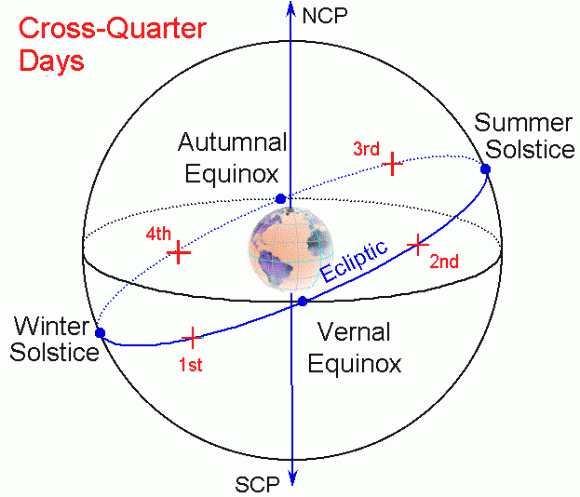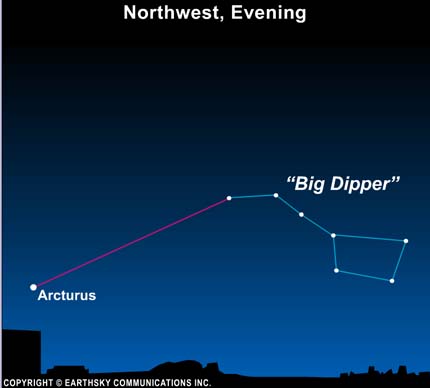Halloween – short for All Hallows’ Eve – is an astronomical holiday. Sure, it’s the modern-day descendant from Samhain, a sacred festival of the ancient Celts and Druids in the British Isles. But it’s also a cross-quarter day, which is probably why Samhain occurred when it did. Early people were keen observers of the sky. A cross-quarter day is a day more or less midway between an equinox (when the sun sets due west) and a solstice (when the sun sets at its most northern or southern point on the horizon). Halloween – October 31 – is approximately midway point between the autumn equinox and winter solstice, for us in the Northern Hemisphere.
In other words, in traditional astronomy, there are eight major seasonal subdivisions of every year. They include the March and September equinoxes, the June and December solstices, and the intervening four cross-quarter days.
In modern times, the four cross-quarter days are often called Groundhog Day (February 2), May Day (May 1), Lammas (August 1) and Halloween (October 31).

Equinoxes, solstices and cross-quarter days are all hallmarks of Earth’s orbit around the sun. Halloween is the fourth cross-quarter day of the year. Illustration via NASA
Halloween is the spookiest of the cross quarter days, possibly because it comes at a time of year when the days are growing shorter. On Halloween, it’s said that the spirits of the dead wander from sunset until midnight. After midnight – on November 1, which we now call All Saints’ Day – the ghosts are said to go back to rest.
The October 31 date for Halloween has been fixed by tradition. The true cross-quarter day falls on November 7, representing a discrepancy of about one week. According to the ancient Celts, a cross-quarter day marks the beginning – not the middle – of a season.

The Pleiades star cluster, also known as the Seven Sisters. This tiny, misty dipper is easy to pick out in the night sky. Photo by Flickr user Dave Dehetre.
The Pleiades connection. It’s thought that the early forbearer of Halloween – Samhain – happened on the night that the Pleiades star cluster culminated at midnight.
In other words, the Pleiades climbed to its highest point in the sky at midnight on or near the same date as this cross-quarter day. In our day, Halloween is fixed on October 31, though the midnight culmination of the Pleiades cluster now occurs on November 21.
Presuming the supposed connection between Samhain and the midnight culmination of the Pleiades, the two events took place on or near the same date in the 11th century (1001-1100) and 12th century (1101-1200). This was several centuries before the introduction of the Gregorian calendar.
At that time, when the Julian calendar was in use, the cross-quarter day and the midnight
Arcturus is a Halloween ghost of the summer sun

TONIGHT FOROCTOBER 31, 2014
 Courtesy U.S. Naval Observatory
Courtesy U.S. Naval Observatory


Myriel RAouine
Arcturus is a Halloween ghost of the summer sun
TONIGHT FOROCTOBER 31, 2014
Every Halloween – and a few days before and after – the brilliant star Arcturus sets at the same time and on the same spot on the west-northwest horizon as the summer sun. What’s more, this star rises at the same time and at the same place on the east-northeast horizon as the sun does during the dog days of summer.
At northerly latitudes, Arcturus sets in the west after sunset and rises in the east before sunrise
However, if you live in the Southern Hemisphere, you can’t see Arcturus right now. South of the equator, Arcturus sets at the same time and on the same place on the horizon as the winter sun. In other words, Arcturus sets before the sun and rises after the sun at southerly latitudes at this time of year.
EarthSky lunar calendars are cool! They make great gifts. Order now...
Cover of 'Star Arcturus, ghost of summer sun' coloring book
In the Northern Hemisphere – around Halloween – this brilliant pumpkin-colored star playacts as the ghost of the summer sun.
At mid-northern latitudes, Arcturus now sets about 2 hours after sunset and rises about 2 hours before sunrise.
By watching this star in the October evening chill, you can envision the absent summer sun radiating its extra hours of sunlight. Not till after dark does this star set, an echo of long summer afternoons. Similarly, Arcturus rises in the east before dawn, a phantom reminder of early morning daybreaks.
You can verify that you’re looking at Arcturus once the Big Dipper comes out. Its handle always points to Arcturus.
By the way, if you live as far north as Barrow, Alaska, the star Arcturus shines all night long, mimicking the midnight sun of summer.
Oct 31, 2014
Dr. SohiniBen Shukla
Dear Sonja,
Thanks for posting all about Halloween....
One week passed already ..!!
Nov 5, 2014
Myriel RAouine
Indeed, and the FULL MOON is approaching :-)
Nov 5, 2014